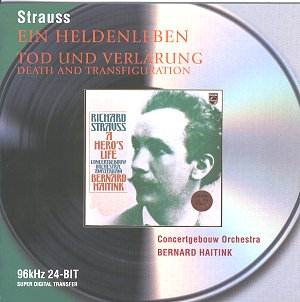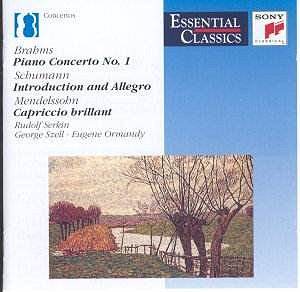 Composer: Richard Strauss
Composer: Richard Strauss
Works: Ein Heldenleben, op. 40; Tod und Verklärung, op. 24
Performers: Concertgebouw Orchestra
Conductor: Bernard Haitink
Label: Philips 50 Great Recordings, 464 743-2
Duration: 74:12
Release Date: October 2001
Review by: Simon Foster
In the realm of orchestral repertoire, Richard Strauss’s Ein Heldenleben and Tod und Verklärung stand as monumental testaments to the lush orchestral language and thematic complexity of the late Romantic era. This reissue of Bernard Haitink’s recordings with the Concertgebouw Orchestra serves not only as a reminder of a distinguished interpretative lineage but also as a vivid portrayal of Strauss’s artistic vision.
Bernard Haitink, conducting the Concertgebouw Orchestra, approaches Ein Heldenleben with a confidence and clarity that are hallmarks of his style. Recorded in 1970, this performance captures the essence of Strauss’s tone poem with a transparency that allows the intricate interplay of motifs to flourish. The opening, marked by a striking boldness, sets the stage for a narrative that unfolds with both vigor and nuance. Haitink expertly navigates the score’s dramatic contours, eschewing the temptation to indulge in excessive tempo fluctuations. This restraint enhances the impact of climaxes, allowing each thematic development to resonate with a palpable sense of inevitability.
The orchestral balance is particularly noteworthy. The Philips engineers of the era have achieved a remarkable sonic equilibrium, where the lush textures of the strings intermingle seamlessly with the vivid brass and woodwinds. In the section titled ‘The Hero’s Works of Peace,’ the horns ascend majestically, their sound cutting through the orchestral fabric with a purity that is both commanding and lyrical. This is a testament to the skill of the brass section, whose performance throughout the work is marked by a blend of power and finesse.
Haitink’s interpretation shines particularly in the characterizations drawn from the orchestra. The portrayal of Strauss’s wife, Pauline, through the violin passages played by Herman Krebbers, is executed with an exquisite delicacy. Krebbers imbues the capricious nature of the character with a sensitivity that feels both personal and universal, reflecting the multifaceted emotions inherent in Strauss’s writing.
Conversely, Tod und Verklärung, recorded in 1981, presents a different sonic landscape—one that is emblematic of the transitional period in recording technology. While the performance is undeniably compelling, the sound is less integrated than in Ein Heldenleben, possessing a certain distance that occasionally detracts from the immediacy of the emotional impact. Nonetheless, Haitink’s control over dynamics is commendable, particularly in the pivotal transfiguration section. The gradual build from the tumult of the opening to the serene resolution is executed with precision, showcasing the full range of the orchestra’s capabilities.
While Tod und Verklärung may not reach the exalted heights achieved in the earlier work, it nonetheless offers moments of profound beauty and emotional depth. The strings, despite a few moments of imprecision, deliver a rich tapestry of sound that captures the essence of Strauss’s exploration of life and death. The thematic material, characterized by the tension between struggle and transcendence, is conveyed with an earnestness that resonates with listeners.
In comparing these recordings to other notable interpretations, such as those by Herbert von Karajan or Georg Solti, Haitink’s approach is marked by a more organic unfolding of the musical narrative. While Karajan often imbues his performances with a dramatic flair, Haitink’s textural clarity and focus on ensemble cohesion provide a refreshing alternative that may appeal to discerning listeners.
The engineering quality of this reissue deserves commendation. The 96kHz 24-bit transfer breathes life into the analogue recordings, maintaining an open and transparent sound that captures the warmth and impact of the original sessions. The clarity allows for the intricate web of motifs and counterpoints to emerge, reflecting Strauss’s penchant for simultaneous melodic strands that intertwine in a rich tapestry.
In conclusion, this reissue of Haitink’s Ein Heldenleben and Tod und Verklärung not only encapsulates a significant moment in classical recording history but also serves as an enduring testament to the interpretative prowess of one of the great conductors of the 20th century. The performances are marked by a profound understanding of Strauss’s intentions, revealing the emotional depth and complexity of his works. As we revisit these recordings, we are reminded not only of the artistry of Haitink and the Concertgebouw but also of the enduring power of Strauss’s music to engage and inspire. This collection is indeed a valuable addition to any classical music library—a true celebration of the orchestral tradition.



